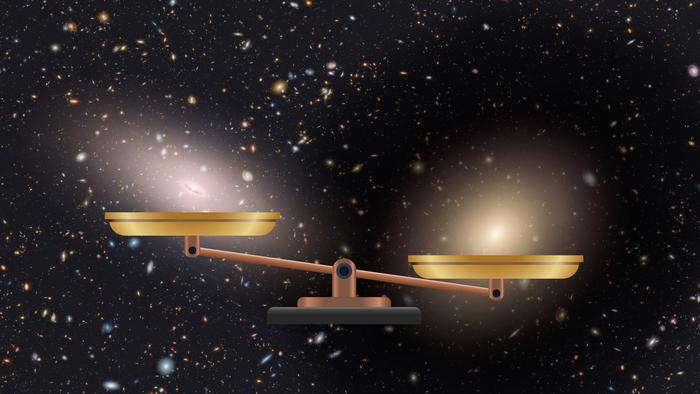A team of scientists, led by the researcher at the IAC and the University of La Laguna (ULL) Sebastién Comerón, has found that the galaxy NGC 1277 does not contain dark matter.This is the first time that a massive galaxy (it has a mass several times that of the Milky Way) does not show evidence for this invisible component of the universe. “This result does not fit in with the currently accepted cosmological models, which include dark matter” explains Comerón.

Credit: Design: Gabriel Pérez Díaz (IAC). Image of NGC 1277: NASA, ESA, and M. Beasley (IAC). Image of ESO 325-G004: NASA, ESA, and The Hubble Heritage Team (STScI/AURA); J. Blakeslee (Washington State University)
A team of scientists, led by the researcher at the IAC and the University of La Laguna (ULL) Sebastién Comerón, has found that the galaxy NGC 1277 does not contain dark matter.This is the first time that a massive galaxy (it has a mass several times that of the Milky Way) does not show evidence for this invisible component of the universe. “This result does not fit in with the currently accepted cosmological models, which include dark matter” explains Comerón.
In the current standard model cosmology massive galaxies contain substantial quantities of dark matter, a type of matter which does not interact in the same way as normal matter; the only evidence for its existence is the strong gravitational pull which it exerts on the stars and the gas nearby, and this interacton is observable.
NGC 1277 is considered a prototype “relic galaxy” which means a galaxy which has had no interactions with its neighbours. Galaxies of this type are very rare, and they are considered the remnants of giant galaxies which formed in the early days of the universe.
“The importance of relic galaxies in helping us to understand how the first galaxies formed was the reason we decided to observe NGC 1277 with an integral field spectrograph” explains Comerón. “From the spectra we made kinematic maps which enabled us to work out the distribution of mass within the galaxy out to a radius of some 20,000 light years” he adds.
The team discovered that the mass distribution in NGC 1277 was just the distribution of the stars, and from this they inferred that within the radius observed there cannot be more than 5% of dark matter, although the observations are consistent with the complete absence of this component.
However, present cosmological models predict that a galaxy with the mass of NGC 1277 should have at least 10 % of their mass in the form of dark matter, with a maximum of 70 % in this form. “This discrepancy between the observations and what we would expect is a puzzle, and maybe even a challenge for the standard model” notes Ignacio Trujillo, a researcher at the IAC and the ULL, who participated in the study.
The article suggests two possible explanations for the lack of dark matter in NGC 1277. “One is that the gravitational interaction with the surrounding medium within the galaxy cluster in which this galaxy is situated has stripped out the dark matter” comments Anna Ferré-Mateu, a researcher at the IAC and the ULL who also participated in the study. “The other is that the dark matter was driven out of the system when the galaxy formed by the merging of protogalactic fragments, which gave rise to the relic galaxy”.
For the authors of the study neither of these explanations is fully satisfactory “so the puzzle of how a massive galaxy can form without dark matter remains a puzzle” insists Comerón. In order to continue researching the mystery the team plans to make new observations with the WEAVE instrument on the William Herschel Telescope (WHT) at the Roque de los Muchachos Observatory, in the Canary Island of La Palma
If this the result, that NGC 1277 does not have dark matter, is confirmed, it would cast strong doubt on alternative models for dark matter, namely theories in which gravity is modified and the major part of the gravitational attraction within galaxies is due to a slight change in the law of gravity on large scales. “Although the dark matter in a specific galaxy can be lost, a modified law of gravity must be universal, it cannot have exceptions, so that a galaxy without dark matter is a refutation of this type of alternatives to dark matter” notes Trujillo.
Journal
Astronomy and Astrophysics
DOI
10.1051/0004-6361/202346291
Article Title
The massive relic galaxy NGC 1277 is dark matter deficient. From dynamical models of integral-field stellar kinematics out to five effective radii
Article Publication Date
11-Jul-2023




